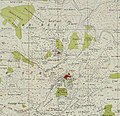History
Ceramics from the Byzantine era have been found here. [5]
Seven ruins are shown on the plan north of this village within about a mile. They are ancient watch towers, like those of Azzun. [6] One of them, known as Gasr Bint esh-Sheikh, dates from the late Hellenistic and early Roman periods. [7] [8]
Ottoman era
Al-Ras was incorporated into the Ottoman Empire in 1517 with all of Palestine, and in 1596 it appeared in the tax registers as being in the Nahiya of Bani Sa'b of the Liwa of Nablus. It had a population of 25 households, all Muslim. The villagers paid a fixed tax-rate of 33,3% on various agricultural products, including wheat, barley, summer crops, olive trees, goats and/or beehives in addition to occasional revenues and a fixed tax for people of Nablus area; a total of 6,600 akçe. All the revenues went to a waqf. [9]
In 1838, Robinson noted er-Ras as a village in Beni Sa'ab district, west of Nablus. [10]
In 1870/1871 (1288 AH), an Ottoman census listed the village with 23 Household in the nahiya (sub-district) of Bani Sa'b. [11]
In 1882 the PEF's Survey of Western Palestine (SWP) described Er Ras as: "a small hamlet on a high knoll, supplied by cisterns, with olives below on the north." [12]
British Mandate era
In the 1922 census of Palestine conducted by the British Mandate authorities, Ras had a population of 92 Muslims, [13] increasing in the 1931 census to 119 Muslims, living in 26 houses. [14]
In the 1945 statistics the population of Er Ras was 160 Muslims, [15] with 5,646 dunams of land according to an official land and population survey. [16] Of this, 1,029 dunams were plantations and irrigable land, 2,027 were used for cereals, [17] while 3 dunams were built-up (urban) land. [18]
Al-Ras 1942 1:20,000
Al-Ras 1945 1:250,000
This page is based on this
Wikipedia article Text is available under the
CC BY-SA 4.0 license; additional terms may apply.
Images, videos and audio are available under their respective licenses.



